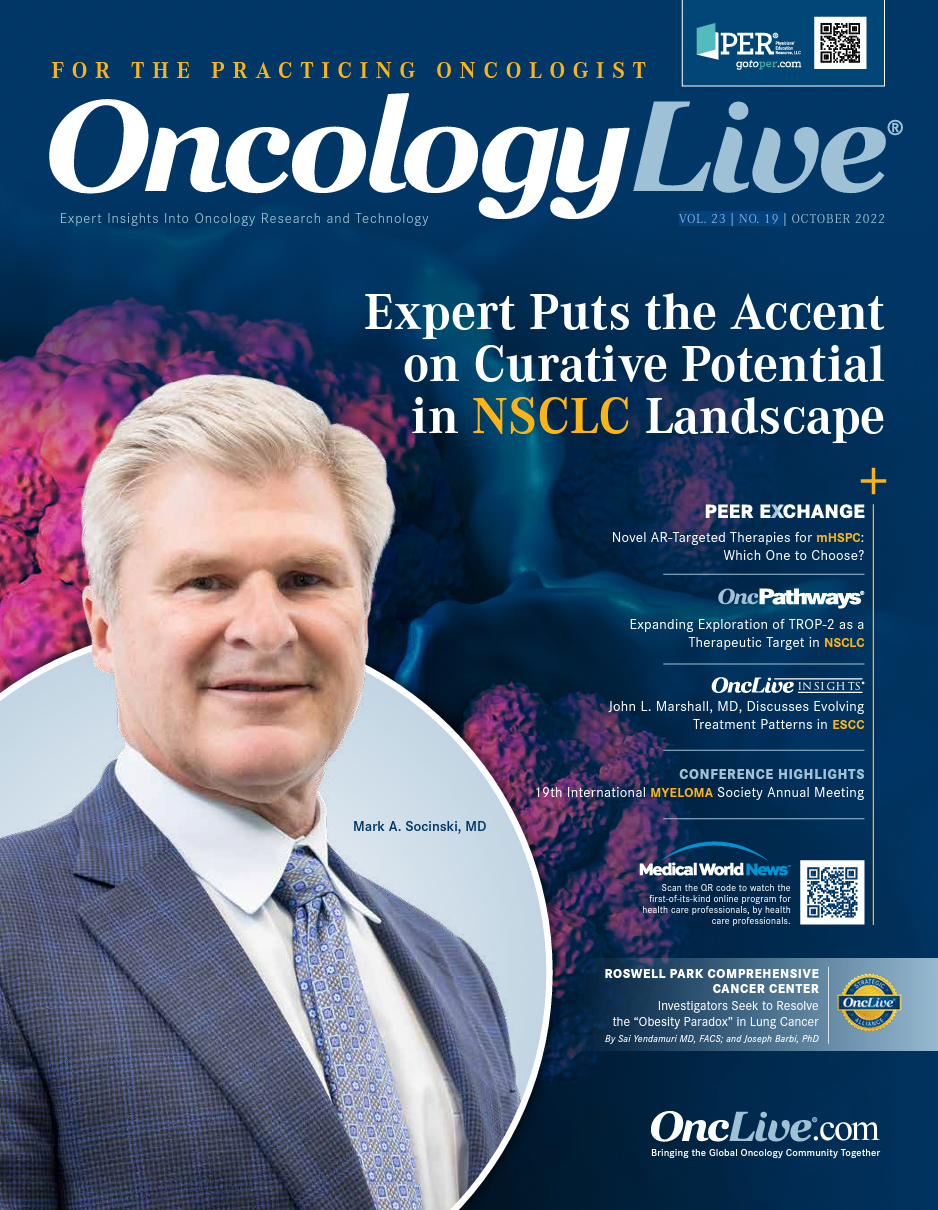Cost Minimization Relies on Sequencing in Metastatic Breast Cancer
Sequencing complexities with chemotherapy-based regimens in metastatic breast cancer pose unique challenges for valuebased decision-making in routine practice.

Sequencing complexities with chemotherapy-based regimens in metastatic breast cancer (mBC) pose unique challenges for valuebased decision-making in routine practice. Selection of chemotherapy options requires risk quantification, patient preference, and clinical context of the patient being cared for, including socioeconomic factors.
According to results of a dynamic microsimulation of 10,000 women with mBC divided into 3 cohorts based on commonly observed baseline characteristics, investigators found that treatment sequences offered “indistinguishable differences” in the quality-adjusted life year (QALY) assessments but had notable differences in cost. “We also found that the relative difference in total costs associated with each alternative sequence was quite variable by cohort, with cohort 3 [patients with taxane- exposed/anthracycline-naïve disease] having the smallest percentage change in cost by sequence,” the study authors wrote.1
Several approved agents are available for firstline treatment of patients with mBC; however, most will experience disease recurrence, and sequencing guidelines are unclear. To provide insight on appropriate treatment pathways for patients with endocrine-refractory or triple-negative mBC, investigators sought to elucidate tradeoffs in quality of life and cost.
Illuminating Costs of Sequencing Decisions
Building a model that reflected a dynamic microsimulation, 10,000 women 18 years or older in each cohort who experienced monthly events for 10 years or until death were followed to evaluate outcomes of various sequencing patterns of systemic therapies. All clinical scenarios evaluated in the model had participants either progress or demonstrate intolerance to first-line treatment.
Investigators leveraged insights from 2 clinical experts on the study team and 6 external medical oncologists to develop a treatment portfolio that would reflect real-world clinical scenarios for the 3 treatment groups as follows:
- Unexposed to either taxane or anthracycline
- Taxane- and anthracycline-exposed, and
- Taxane-exposed/anthracycline-naive.
Additionally, NCCN guidelines were used to generate recommended single-agent cytotoxic therapies, which were then evaluated against data from MarketScan and by a number of external advisers at academic institutions and the Centers for Disease Control and Prevention. Investigators noted that although patients may receive combination therapies in clinical practice, the model was simplified to provide meaningful insight for monotherapy treatment pathways only.
Input parameters for the simulations including presumptions for overall survival (OS) and progression-free survival (PFS) were based on data from the EMBRACE trial (NCT00388726), PELICAN trial (NCT00266799), and a phase 3 trial (NCT00078572). These studies evaluated eribulin mesylate vs treatment of physician’s choice, pegylated liposomal doxorubicin plus capecitabine, and lapatinib plus capecitabine vs capecitabine, respectively. The median OS for comparison was 25.14 months, assuming equal efficacy, with a median PFS in the first line of 5.96 months and a median PFS in subsequent lines of therapy of 4.02 months.
“In our primary analyses, we treated survival as equivalent across treatments, following existing guidelines and best available evidence,” the authors wrote, adding it was assumed that all participants would not respond to or tolerate first and subsequent therapies. “In this way, each [participant] could conceivably receive all 3 treatment options within each of the 3 clinical scenarios, creating 6 potential treatment sequences for comparison within each cohort.”
Adverse effects (AEs) of grade 3 or higher included in the simulation were neutropenia, anemia, fatigue, peripheral neuropathy, diarrhea, dyspnea, stomatitis, and hand-foot syndrome. Costs for each AE were calculated for all treatments and adjusted to 2018 costs. Additional inputs included monthly chemotherapy costs, monthly nonchemotherapy costs for first- through fourth-line therapy and palliative care, monthly indirect costs including lost income for patient and caregiver, and utility decrements.
Overall, after 25 months, nearly all participants regardless of cohort progressed through 3 lines of treatment, with investigators reporting approximately 33% of participants had died. After 120 months, nearly all participants had died.
Cohort 1: Taxane- and Anthracycline-Unexposed Patients
For patients ineligible for first-line taxane or anthracycline and for those who are not considered candidates for retreatment, preferred treatment choices include paclitaxel, capecitabine, and docetaxel. Sequencing in this cohort examined 6 potential courses of treatment for these patients. “Results suggest that for taxane- and anthracycline-unexposed patients (cohort 1), treatment with paclitaxel followed by capecitabine followed by docetaxel corresponds to the highest expected QALY gain and lowest costs,” the study authors wrote.
Specifically, beginning treatment with paclitaxel started costs at $686 per month vs $3233 per month if starting with capecitabine and $1765 per month if starting with docetaxel. Investigators observed the difference in QALY survival was fewer than 3 days between the best and next-best regimen, with sensitivity analysis confirming and showing both sequences that began with paclitaxel were noticeably less costly for patients.
Cohort 2: Taxane- and Anthracycline-Exposed Patients
The 3 agents considered appropriate for patients who are ineligible for or refractory to taxane and anthracycline therapies included capecitabine, eribulin, and carboplatin. At $190 per month, carboplatin was the most cost-effective option and had the best safety profile of the 3 agents. Therefore, all sequences starting with this agent had the lowest cost.
Investigators also noted that at low levels of QALY gain, there were smaller differences in starting with capecitabine vs carboplatin. However, all sequences starting with eribulin were of high cost, and it was noted that reference data for eribulin in the first-line metastatic setting were from patients who were heavily pretreated and refractory to capecitabine. The data, however, point to a rationale for conducting a threshold analysis to evaluate for cost effectiveness.
Cohort 3: Taxane-Exposed/ Anthracycline-Naive Patients
The final cohort of patients includes those who are considered refractory to taxane therapy only. These patients are eligible for treatment with pegylated liposomal doxorubicin, capecitabine, and eribulin. Sequencing with eribulin first did not elicit high numbers of QALYs compared with sequencing starting with pegylated liposomal doxorubicin or capecitabine.
Furthermore, sequencing eribulin after capecitabine had an estimated cost of $8000 per month compared with $1765 per month for pegylated liposomal doxorubicin following capecitabine. Finally, the difference in starting with either pegylated liposomal doxorubicin or capecitabine resulted in similar cost-effectiveness.
Patient Preferences Play a Role in Treatment Decision-Making
Beyond the value-based lens, patient preference should play a role. “Patients may have individual preferences about treatment (eg, avoiding certain adverse events or minimizing infusion or travel time) that can and should inform decisions. In these cases, although cost-effectiveness information can provide some guidance about the relative cost-benefit tradeoffs, open communication about adverse event risks, preferences, and shared decision-making between patients and providers should continue to influence practice, as recommended by NCCN guidelines in this setting,” they wrote.
The study was not designed to determine out-of-pocket costs for patients for each treatment recommendation. However, according to a projection of mBC cases and costs through 2030, identifying ways to address cost-effective treatment pathways is of utmost importance. The study showed that a 54.8% increase in cases is expected from 2015 to 2030, from 158,997 cases to 246,194 cases. Estimated cost is expected to reach $152.4 billion across age groups and phases of care, up from $63.4 billion in 2015.2 Costs are expected to be higher for younger and midlife patients.
Although the analysis did not account for emerging trends and changes in the treatment landscape, the numbers are sobering. As authors of the cost-effectiveness analysis concluded, “In this mBC setting where multiple chemotherapy options are recommended by guidelines and share similar survival and adverse event trajectories, treatment sequencing approaches that seek to minimize costs early may help improve value of care….Our study suggests that large incremental differences in endocrine-refractory or triple-negative mBC systemic treatment costs are not likely associated with better outcomes, which is informative for oncology value frameworks, pathway development, and policy.”
Notably, the study authors added with small changes in quality-adjusted survival— differences of only days or weeks—“adverse event–driven quality-of-life differences across treatment sequences are not common or burdensome enough to move the needle on value, unless cost differences [exist] between treatments."
References
- Wheeler SB, Rotter J, Gogate A, et al. Cost-effectiveness of pharmacologic treatment options for women with endocrine-refractory or triple-negative metastatic breast cancer. J Clin Oncol. Published online September 2, 2022. doi:10.1200/JCO.21.02473
- Gogate A, Wheeler SB, Reeder-Hayes KE, et al. Projecting the prevalence and costs of metastatic breast cancer from 2015 through 2030. JNCI Cancer Spectr. 2021;5(4):pkab063. doi:10.1093/ jncics/pkab063




